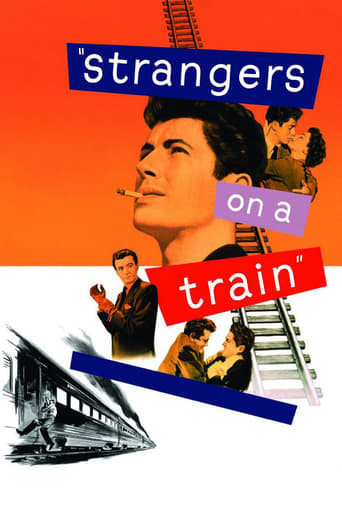Diagonaldi
Very well executed
Grimossfer
Clever and entertaining enough to recommend even to members of the 1%
Lidia Draper
Great example of an old-fashioned, pure-at-heart escapist event movie that doesn't pretend to be anything that it's not and has boat loads of fun being its own ludicrous self.
MJB784
It was my favorite, but in repeated viewings, Psycho adds up more. The scene when Bruno reaches down the sewer to find the cigarette lighter was odd because how could his arm stretch down there? I also found the scene when the guys leave the girl in the carnival before getting strangled very odd. It does have many classic scenes that are very exciting in countless viewings.
zkonedog
When examining the merits of Alfred Hitchcock's "Strangers on a Train", it is clear that the Master of Suspense crafted another winner. What was remarkable to me, however, was how he did it with such a simple plot line...instead creating the suspense from one of the creepiest characters in film history.For a basic plot summary, "Strangers on a Train" sees two men meet up with each other on a random train ride. Guy Haines (Farley Granger) is a young tennis pro who desperately wants a divorce from his vindictive wife. Bruno Antony (Robert Walker) is suffocating under the harsh discipline of is father. When Bruno brings up the thought of a "criss-cross" murder swap to solve both their problems, the film has its fuel.In terms of overall plot, the goings are relatively simple here. This is pretty much par for the course with Hitch, as (with a few exceptions) his films' plots are actually pretty standard and containing the tried-and-true MacGuffins he has become famous for (in this case it is a lighter from the scene of a crime).What makes this film really stand out and engage the viewer, then, is the character of Bruno and subsequent acting job by Walker. From the very beginning, audiences understand how crazy of a man Bruno is, and his character-development only continues the journey down that rabbit hole as the film progresses. He is easily one of the spookiest characters ever put to film.Thus, "Strangers on a Train" is a very good Hitchcock effort. It contains the typical MacGuffin plot device, some very inventive camera work, and a villainous character who just may keep you up at night. Watch with confidence knowing it will captivate you from beginning to end.
Scott LeBrun
One day, two men are traveling by train. Guy Haines (Farley Granger) is a young tennis star and Bruno Antony (Robert Walker) is a socialite. A very *disturbed* socialite. Bruno stubbornly tries to get Guy to agree to an "arrangement". Both men have people in their lives whom they could easily do without. With Guy, it's his promiscuous, mercurial wife Miriam (Kasey Rogers). With Bruno, it's his domineering father (Jonathan Hale). So what Bruno proposes is simple: he will murder Miriam while Guy while murder Mr. Antony. Guy, being a basically decent person, will have none of this, but finds it exceedingly difficult to extract this persistent creep from his life.Alfred Hitchcock works wonders with the ingenious source material, Patricia Highsmiths' novel, which was adapted by Whitfield Cook and scripted by Raymond Chandler and Czenzi Ormonde. His mastery of film is evident with some really neat visual tricks, and of course his handling of key suspense sequences. There's one in the Antony family mansion, and a major set piece four fifths of the way through as Hitch cuts between strenuous efforts to retrieve a lighter and Guy's fevered attempts to win as many games as quickly as possible. The finale is also incredibly exciting and memorable, as it takes place on an out of control merry-go- round. Absolutely no time is wasted, as Guy and Bruno meet within the films' opening minutes and it doesn't take Bruno long to propose his scheme to the understandably miffed younger man.The cast is very good all the way down the line. Granger is a typically personable lead, and there's fine support by Ruth Roman as a loyal girlfriend, Leo G. Carroll as her senator father, Hitchs' daughter Patricia as her perky younger sister, the amusing Marion Lorne as Brunos' doting mother, John Brown as a drunken "witness", and Howard St. John, Robert Gist, and John Doucette as various cops. The sadly short lived Walker easily dominates the story, though, and he does a *superb* job. Keep your eyes pealed for the standard Hitch cameo about ten and a half minutes into the film.Top notch filmmaking and storytelling; this is truly one of the all time great Hollywood thrillers. The premise was later exploited for comedic value in "Throw Momma from the Train".10 out of 10.
ags123
Hitchcock is clearly in his element adapting Patricia Highsmith's quirky novel to the screen. Here again we have a wrongly accused man out to expose the true culprit while attempting to elude the police. However, this time, the hero is not entirely innocent. And the villain is irresistibly charming. Add to that a subtle homosexual undertone making for an engaging and suspenseful film. Robert Walker steals the show in what was a complete reversal of his wholesome image. Also outstanding is Patricia Hitchcock as the wise and witty voice of reason, the most extensive of her roles in three of her father's films. Ruth Roman, culled from Warner's contract players and heavily promoted at the time, is a rather weak link, not the typical Hitchcock blonde, and far too uptight and affected to be convincing as unassuming Farley Granger's love interest. Minor characters - Leo G. Carroll, Marion Lorne, Laura Elliott - excel at adding depth to the story. Of note is the costume design: Bruno's rakish dressing gown has appeared in various Warner Bros. productions, seen on Monty Woolley in 1942's "The Man Who Came To Dinner" and on Milton Berle in 1949's "Always Leave Them Laughing."

